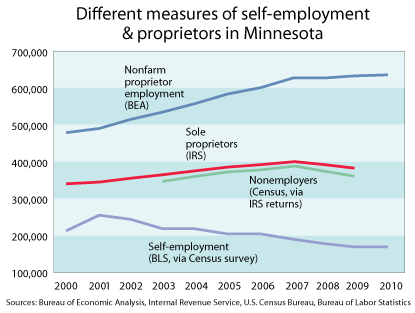
The concept of self-employment is straightforward: People working for themselves, earning income from the businesses they run.
Measuring self-employment might seem like a similarly simple matter. But the taxonomy of self-employment becomes convoluted because the term incorporates virtually any self-initiated activity that earns income—part-time or full-time, for $1,000 or $1 million, raking leaves or building rockets, your solo means of income or a third job you do on weekends for a little spending money.
There are also methodological and definitional differences. Are both incorporated and unincorporated firms included? What about those who own their own business but have a few employees? (Technically, if they are unincorporated, they are still self-employed, at least by one government measure.) Would I be self-employed if I had a partner? (Yes, by some definitions.)
The accompanying chart illustrates the measurement issue. All of the plotted data purport to measure some form or definition of self-employment in Minnesota over roughly the same time period. The individual measures are generally far apart in scale; only two of them even follow the same trend line over time. That’s because each data set has its own unique definition of self-employment. However, there is a significant amount of overlap.
Here’s how the measurements break down, starting with the smallest estimates and working higher, and some of the reasons the counts differ so widely.
Self-employment (Bureau of Labor Statistics): The BLS uses the Current Population Survey, conducted monthly by the U.S. Census Bureau, to estimate self-employment. In this survey, respondents who work are asked, “Last week, were you employed by government, by a private company, a nonprofit organization, or were you self-employed?” Notably, only unincorporated self-employed individuals are counted by the CPS. Sole proprietors who have incorporated their business (say, as a limited liability company) are not counted as self-employed because, technically, they are paid employees (of their own firms) and are instead lumped in with wage and salary workers.
This might seem like methodological hairsplitting, but it makes a big difference in the final count, because the number of incorporated sole proprietors (not shown on the nearby chart) has been trending steadily upward and now accounts for almost two of five sole proprietorships nationwide, according to BLS research published last year.
Nonemployers (U.S. Census Bureau): The Census uses Schedule C filings for business income (part of Form 1040) from the IRS to identify businesses with no paid employees. It also establishes maximum and minimum income cutoffs for consistency within this group. At the upper end, it eliminates sole proprietors reporting more than $1 million in receipts (though it varies by industrial classification) as well as those with less than $1,000 in receipts (except construction) because these firms are believed to represent hobbies as opposed to normal business activities.
Sole proprietors (Internal Revenue Service): These data also use Schedule C filings of business income. As a result, the trend line for sole proprietors closely follows that of nonemployers, but is slightly higher because it includes the small fraction of sole proprietors with employees (estimated to be about 5 percent).
Nonfarm proprietors (Bureau of Economic Analysis): Easily the highest self-employment estimate of any government count, BEA estimates consist of the number of sole proprietorships (using Schedule C tax returns) plus the number of general partners (using IRS Form 1065 tax returns; only one return is filed by each business partnership, but it lists the number of partners). Both are measures of entities that produce income, and neither accounts for those involved in multiple entities. Estimates also count proprietors that are active during any portion of the year, regardless of duration.
The big jump, as well as the steady growth, in BEA figures comes from including partnerships, which have grown in number and total partners, even through the recession. As of 2009, there were about 22.4 million sole proprietors nationwide, as well as 19.3 million partners in more than 3 million partnerships.
Ron Wirtz is a Minneapolis Fed regional outreach director. Ron tracks current business conditions, with a focus on employment and wages, construction, real estate, consumer spending, and tourism. In this role, he networks with businesses in the Bank’s six-state region and gives frequent speeches on economic conditions. Follow him on Twitter @RonWirtz.






